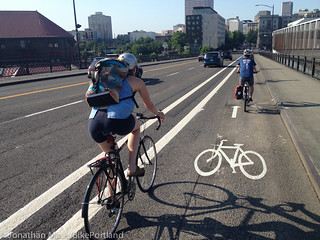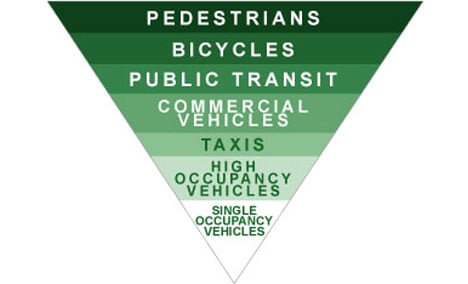How much is a bike lane worth?
As the City of Portland begins moving toward an overhaul of its auto parking policy, the people on two massive parking-reform stakeholder committees (one for the central city and one for neighborhood commercial districts) are beginning to confront an interesting problem.
If modern acolytes of market-priced street parking are correct, it’s actually not hard to discover the economic value of an on-street auto parking space: use meters or permits to raise the price of parking until 15 percent of spaces in a given area — about one per block — are always empty and available. It’s the curbside equivalent of a store that’s acquiring new inventory at the same rate that it sells its current stock.
But no such simple formula exists for calculating the value of something else that the City of Portland says it hopes one day to have on most of its major streets: protected bike lanes. And in the absence of such a measurement, some committee members worry that the city may be tumbling toward a system that would merely enshrine the city’s curbsides as places to park cars, though somewhat more expensively than before.
“All sorts of things could go where parking goes, and the city doesn’t really have a coherent policy as to when we choose to put parking there.”
— Grant Morehead, PBOT
“All sorts of things could go where parking goes,” Grant Morehead, the city’s lead staffer on the Centers and Corridors parking stakeholder committee, which is focusing on mixed-use neighborhoods like Hollywood and North Mississippi Avenue. “And the city doesn’t really have a coherent policy as to when we choose to put parking there.”
Mauricio Leclerc, Morehead’s counterpart on the new Central City parking stakeholder committee, said Thursday that the city needs to create an “objective measure” that could capture how important a given parking space is.
But he wasn’t sure how to create a similar measure to weigh that one against when it came to mobility such as a dedicated bike lane, bus lane, or turn lane.
Letting the market put a price on that parking space’s value would be one way to take such a measurement. But (at least until all vehicles, including bicycles, are charged a fraction of a cent for each roll of their wheels) no such pricing system is available for people biking on a street.
“How do we make that tradeoff?” Morehead asked stakeholders Thursday. “How do we determine when one mode is more important than another?”

(Photo: M.Andersen/BikePortland)
Those present talked intelligently about that and other issues, in large and small groups, for two hours. But no clear answer seemed to be emerging.
Advertisement
Ian Stude, chair of the Portland Bicycle Advisory Committee and a member of the Centers and Corridors committee, said a subgroup of bike-friendly committee members had met before Thursday’s meeting to compare notes and discuss what to ask for. He said they, too, had reached no clear conclusions.
“We mostly ended up talking about process,” Stude said.
Chris Smith, a city planning and sustainability commissioner also on the Centers and Corridors committee, asked Morehead if he thought Portland’s “green transportation hierarchy,” a pyramid that supposedly informs all decisions in the city’s transportation system plan, ought to apply.
“Shouldn’t that inform this prioritization as well?” Smith asked.
Morehead didn’t disagree.
As the meeting wrapped up, committee member Sean Green of the Laurelhurst Neighborhood Association told Morehead and Leclerc that he fears that unless the city moves to create some sort of system for evaluating the importance of any given bike lane, the economic value of on-street parking to local businesses and residents will always trump the citywide economic value that would be created by a complete network of direct all-ages bikeways.
Outside the building, Green said he was taking part in the year-long parking stakeholder process largely out of his frustration with the city’s decision last year to prioritize auto parking over any dedicated space for bikes on 28th Avenue.
“We were told that this process would be an answer to those problems,” he said.




